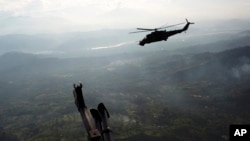Peru established a no-fly zone over its most lawless coca-producing region in a bid to stop a growing number of small planes from smuggling cocaine to neighboring countries, the government said on Wednesday.
The move advances President Ollanta Humala's plan to start forcing down unauthorized flights for the first time since 2001, when the military accidentally shot down a plane carrying a U.S. missionary and her baby.
The no-fly zone bars civilian aircraft without prior military approval from traveling over a part of a group of remote jungle valleys where most of Peru's cocaine is produced, said Alberto Otarola, who heads the Devida anti-drug agency.
“Any flight that is not reported to the aviation authority will be considered hostile and illegal,” Otarola said at a news conference. “Peru must exercise the full sovereignty and jurisdiction of its airspace.”
The area is known as VRAEM, an acronym for “Valley of the Apurimac, Ene and Mantaro rivers.”
Using light aircraft is one of the most common ways of smuggling cocaine from the Andean nation, according to Peru. Most of the drug lands in Bolivia before being transported to Brazil and other countries.
Interceptions part of plan
Otarola said he expects Congress to approve legislation in March that will allow authorities to intercept unauthorized aircraft suspected of carrying drugs, reversing a ban on the practice that followed the incident in 2001.
Otarola said the military would only consider shooting a plane down as a last resort.
The United States, which supports Humala's anti-drug policies, is legally barred from providing certain types of aid to countries that allow authorities to shoot down suspected drug trafficking planes.
Peru is considered one of the world's top producers of cocaine and coca by the United States and United Nations. Between 150 and 180 tons of cocaine were flown via light aircraft from Peru in 2013, according to a U.S. estimate.
The government plans to eradicate 35,000 hectares (135 square miles) of coca this year, up from the 31,200 hectares (120 square miles) uprooted in 2014 that thwarted the production of about 240 tons of cocaine, Otarola said.
Otarola declined to say whether this year's eradication goal includes destroying coca plants in the VRAEM, where a remnant band of Shining Path rebels help drug traffickers and often ambush security forces.
Peru had 49,800 hectares (190 square miles) of coca planted in 2013, according to the United Nations.
LIMA —





